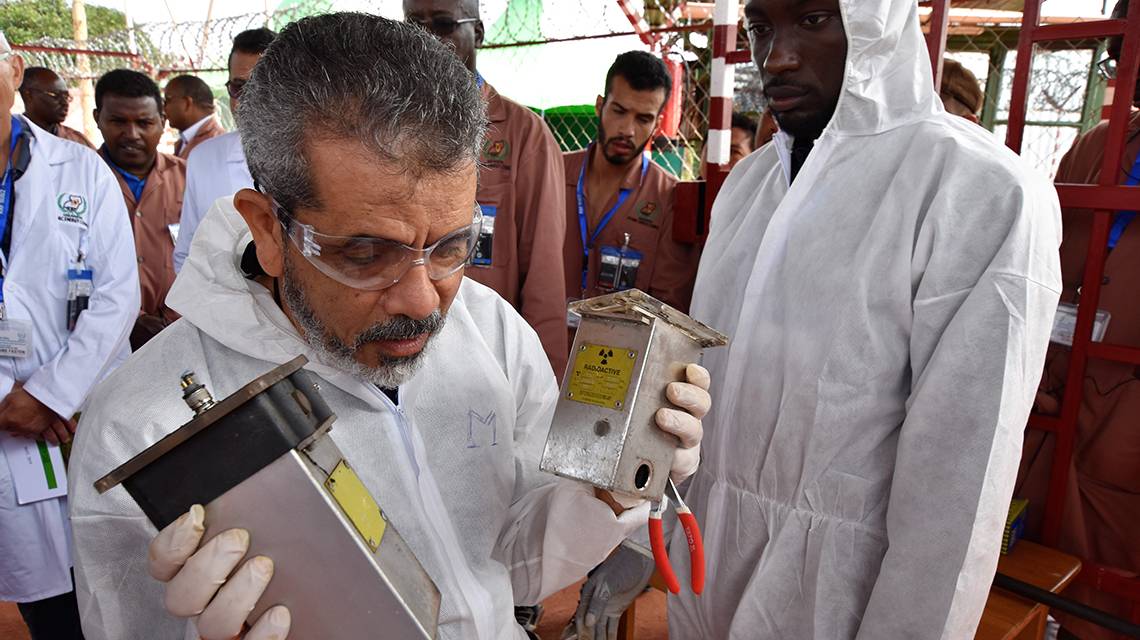The appropriate processing, conditioning and storage of disused sealed radioactive sources (DSRSs) is essential to ensure the safety and security of people and the environment. These activities, however, can be challenging, particularly for countries that do not yet have domestic know how. Therefore, the IAEA has supported the development of an approach to DSRS management which is simpler and more cost effective for countries with relatively few DSRSs. An IAEA training course in Kampala, Uganda, used, for the first time, this new concept.
The approach involves a facility which provides all the necessary elements for the processing, conditioning and storage of low-activity, neutron- and gamma-emitting sources, of the type typically used in industry and medicine. Called the '2 ISO Container' concept, the facility comprises two standard shipping containers - placed in close proximity to one another - outfitted with appropriate ventilation, contamination control, safety and security infrastructure. One container serves as a processing and conditioning facility, while the other provides for the receipt and interim storage of low-activity disused sealed radioactive sources and then of the conditioned sources.
The facility and its procedures benefitted from an international peer review. A panel of international radioactive waste management experts - from Germany, Ghana, Morocco and the United States - was convened to observe the functioning of the 2 ISO facility as well as the training course itself. They also reviewed the facility and the technical procedures of waste management - from initial receipt to eventual storage - in order to assess the approach against all relevant international standards and best practices. These efforts, financially supported by the European Union, are part of a broader IAEA initiative under the African Regional Cooperative Agreement for Research, Development and Training related to Nuclear Science and Technology (AFRA), which is focused on providing support to African countries in strengthening their legal and regulatory infrastructure for nuclear safety and security. Use of the facility with active radioactive sources will need to be licensed by the national regulatory body in each country. In Uganda, this had been done prior to the training. "This approach has been implemented in line with the IAEA Safety Standards," said Deogratias Sekyanzi, CEO of the Uganda Atomic Energy Council, the country's regulator.
Some countries, such as Cameroon, have well advanced plans for using shipping containers for the storage of disused sealed radioactive sources, but in other countries the safety of this method has not yet been demonstrated. Under a new technical cooperation project, launched this year, the IAEA is working to increase the capabilities of national organizations to demonstrate the safety of storage, explained David Bennett, a waste safety specialist at the IAEA.

Trainees watch as an IAEA expert removes a disused source - previously deployed in an industrial context - during the course of the hands-on exercise. (Photo: O. Yusuf/IAEA)
The 'Container and Capsule Approach'
Once the facility has been constructed, the next step is to retrieve the radioactive sources from their devices in line with the requirements and guidance outlined in the Code of Conduct on the Safety and Security of Radioactive Sources and the IAEA Safety Standards. At the heart of the proposed approach are technical procedures that local personnel must follow to recover the disused sources and condition them into a form suitable for storage. The procedures involve the use of a special capsule made from stainless steel into which the disused sources are sealed. The design of this capsule enables proper sealing without the use of specialized equipment, making it easy to handle in any country. Once sealed, the capsule containing the sources is placed inside a lead shield, which in turn is put in a concrete-lined barrel that serves as a package for DSRS storage and transportation.
"A new facility of the type demonstrated in Uganda can be built on an area of less than 1,000 square-metres and for an affordable cost," said Mohamed Al-Mughrabi, a senior IAEA expert.
Training Africa's radioactive waste managers
As part of its ongoing efforts to support the control of disused sealed radioactive sources around the world, the IAEA is organizing a series of hands-on training courses, delivered through the IAEA technical cooperation programme, including the construction, licensing and use of 2 ISO Container facilities. These training courses are expected to be conducted throughout Africa, particularly where waste processing, conditioning and storage facilities do not yet exist.
Following demonstrations of the 2 ISO Container approach in Uganda, Cameroon, Senegal and Zimbabwe, and benefiting from the conclusions of an international technical peer review, plans exist to introduce the concept to more countries, including Cameroon, Ethiopia, Madagascar and Nigeria.

Throughout the week-long training course, participants were expected to respect and observe the highest standards of radiation protection and safety. (Photo: O. Yusuf/IAEA)






